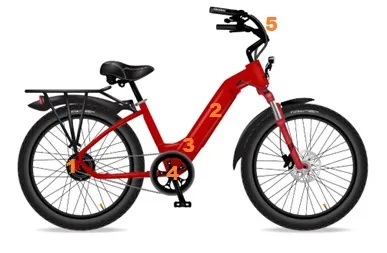What’s An eBike?
.
NATIONAL eBIKE
Effortless Electric Adventures®.
How does an electric bike work?
Electric bicycles (eBikes) combine traditional bicycle and electric components designed to “assist” operation. An eBike pedals and handles much like a regular bicycle, and often uses many of the same components too.
The electric component is meant to augment human power, not completely replace it. It makes obstacles like hills and headwind more manageable and allows you to travel further without getting as tired.
Electric bikes have six (6) components that make them different from a typical bicycle. This includes a motor, battery, controller, sensor, display, and electric wiring.
Components
.
1. Motor
The motor provides the power. Hub motor configurations (rear wheel) are the most popular option compared to a mid-drive configuration (the difference between the two will be explained when you visit our shop). Electric bike motors come in a wide variety of power and torque ratings.
2. Battery
We only sell bikes with approved (UL Listed, Certified) Lithium-Ion batteries. L-ion batteries are much lighter and more powerful than previous technologies, with sufficient capacity to meet a bike’s configuration requirements.
3. Controller
The controller is the “brains” of an electric bike. The controller determines enables features and greatly influences the performance of the bike. Many ebike controllers are hidden inside the frame or inside a protective case if mounted onto the frame.
4. Sensor
Sensors respond to the movement of pedals. When in “pedal-assist” the motor is engaged; when the pedals stop, so does the motor. Most of our models are equipped with a torque sensor (a more natural ride that adjusts to pressure placed on the pedals). Cadence sensors provide a uniform power across pedal-assist speeds. We can explain each in detail when you visit our shop.
5. Display
The display is how the rider and controller communicate with each other. The rider typically makes selections by pressing on a pad or screen, and the controller display information via a screen or lights on the device. In some cases, the display/controller are combined in a single device.
6. Electric Wiring
Electric bikes typically use “plug and play” wiring that is reliable and waterproof.
Riding Modes
.
Bicycle Mode
(Human Power)
Electric bicycles can be pedaled just like a non-electric model (sometimes referred to “class 1” cycling). Although an eBike is heavier than an average bike, the use of gears make riding without power manageable in our area.
Pedal Assist Mode
(Electric Assist)
Once you turn on this mode via the display/controller, the motor will provide approximately 50% of the work as you pedal. You can use the gears to adjust for a more comfortable ride. We sell bikes with (5) Pedal-Assist Speeds (PAS) that provide 50% of the work. With speed 1, the bike does 50% of the work and paces you for a nice, casual ride (about 7-9 mph). Speed 5 does 50% of the work and paces you for the top speed. Speeds 2 thru 4 are bracketed between the speeds 1-5. Pedal assist can be up to 20 mph (class 2 cycling) or 28 mph (class 3 cycling).
All-Electric Mode
(Throttle Only)
The throttle is available to supplement or replace pedaling entirely. Often referred to as “throttle” or “electric only” mode, you can push the throttle to assist further in pedal-assist mode. This is especially useful when crossing an intersection or climbing a hill (or bridge). You can also continue your travels without pedaling at all by using just the throttle. Simply let off the throttle when you’re ready to start pedaling again or coming to a stop.
Combination Mode
(Pedal Assist + Throttle)
With pedal-assist mode you can supplement or replace pedaling with the throttle. Combining pedal-assist with throttle gives you additional flexibility to tackle different terrain and conditions (such as going over a bridge) with ease.






